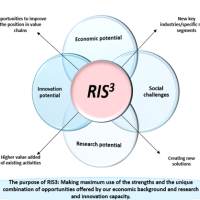In recent years, smart specialisation strategies have been a widely used concept to support research and innovation, especially in EU countries. As the name suggests, the concept is oriented towards the “smart, intelligent” exploitation and development of a country’s or region’s potential, aiming to create long-term competitive advantages that are based on knowledge exploitation and innovation. The concept of smart specialisation needs to be perceived as a new approach to innovation policy, where – instead of overall support for research and innovation activities – state interventions focus on selected priority areas with a high potential for the development and application of new knowledge in economic activities. The strategy builds on the strengths of a country or region and its specific capacities and resources in terms of economics, innovation and research (see the figure below).
The purpose of RIS3 is to make the most of the unique combination of opportunities presented by the economic background and the research and innovation capacity of a country or region. Recognising and systematically developing these opportunities then leads to higher-value-added activities, shifts within value chains and the creation of specific market niches and segments that give the country a competitive advantage in international markets.
Recently, the concept of RIS3 has been joined by issues of societal challenges and megatrends – these are addressed in a way that aims to not only improve the quality of life for people, but also to create opportunities for economic development. In line with this trend, EU-level research and innovation support policy increasingly focuses on a “mission-oriented innovation policy”, i.e., a policy that channels public and private investments towards specific objectives and missions. Also, a key characteristic of this approach to innovation policy is emphasis on the role that major societal challenges can play in creating new markets (both local and global) and in supporting national and/or regional competitiveness.

At the same time, RIS3 strategies recognise the need to address the cross-cutting problems of the R&D&I system as a whole so that the country’s outlined potential is not hindered by barriers arising from these problems. RIS3 therefore also targets cross-cutting or systemic measures that are aimed at improving the basic background necessary for facilitating the functional development of the country’s strengths and its knowledge and innovation potential.
The guidelines for smart specialisation strategies are complemented by the relatively sophisticated logic of the conceptual framework of the strategies and especially the processes that are tied to this framework. In terms of the entire RIS3 concept, these processes are at least as important as the actual strategic documents that frame RIS3. It is safe to say that the RIS3 strategy is a process that focuses on diffusing technology and innovation rather than a stand-alone innovation policy in the true sense of the word.
The starting point of RIS3 and its basic framework consist of determining the priorities (specialisation domains), which are identified based on economic data, assessing innovation capacity and the expertise of representatives of the public and private sectors in a collaborative process involving all relevant parties. The identification of priority areas is then followed by the identification of desirable directions for the development/transformation of these areas. The entrepreneurial discovery process (EDP) plays a crucial role, especially in the area of specialisation domains. This process is about specifying the specialisation domains and the themes or directions to be supported within them. The process also focuses on defining the nature, scope and purpose of the interventions needed to develop and transform these areas. To this end, the EDP process brings together representatives of business and research, as well as public administration. This process must continue throughout the implementation of the strategy, as it provides feedback and verification for the interventions implemented, but also acts as the starting point for the plan of interventions to be prepared. Last but not least, another purpose of the EDP process is to build trust and create networks for fostering collaboration between participants in the national and/or regional innovation systems.
Of course, the results of the EDP process cannot be rigidly planned out. Therefore, the RIS3 strategy is and, by definition, must remain dynamic and flexible so that the results of the processes that are tied to it can be translated into support programmes by the state.